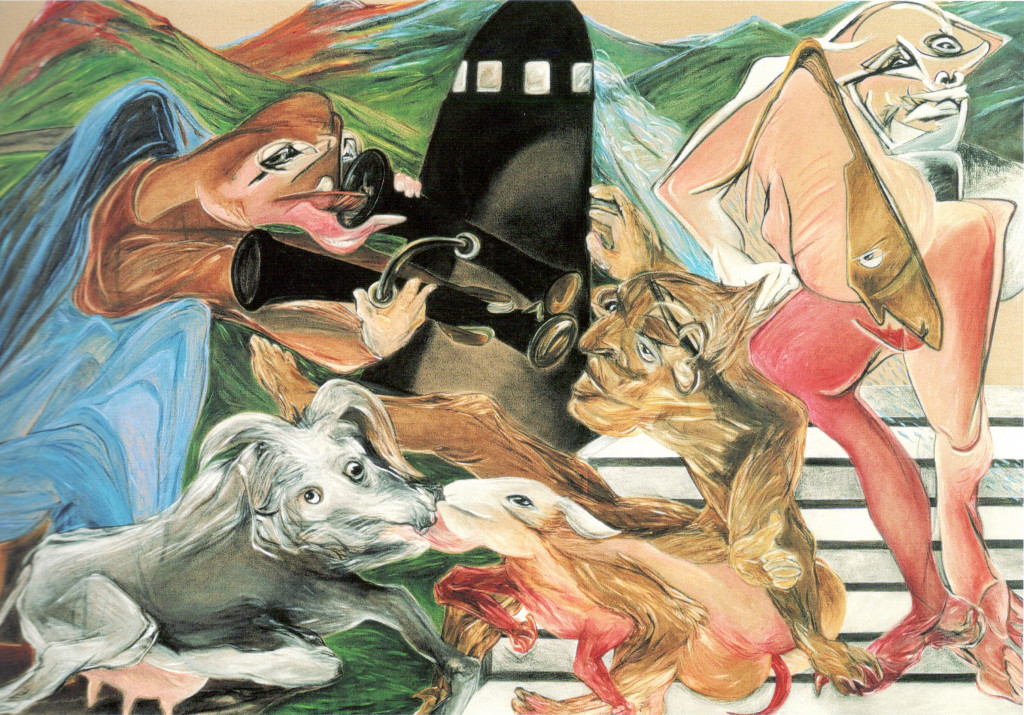Pinball Wizard
The Work and Life of Jacqueline de Jong
News — Jan 18, 2019
9 February - 18 August 2019
The Stedelijk Museum presents a large survey of work by the distinguished, versatile artist Jacqueline de Jong (Hengelo, 1939). Occupying 13 galleries, Pinball Wizard – The Work and Life of Jacqueline de Jong presents the multi-faceted oeuvre created by the artist since the nineteen sixties, in which she switches effortlessly between various styles such as Abstract Expressionism, new figuration and Pop Art. Her work also ranges in scale, from small diptychs that chronicle a day in the life of the artist, to monumental canvases dominated by an absurd and often violent and erotic world.
Relationship with the Stedelijk
When director Willem Sandberg appoints Jacqueline de Jong as an assistant in the applied art department (1958-1960), it signals the beginning of an extraordinary relationship between the artist and the Stedelijk. It not only deepens her admiration of the museum’s collection but, as an artist with no formal art education, serves as a training ground for her own work. In light of which, the current exhibition—which presents her work in the company of artwork from the collection—is even more extraordinary. Like a true ‘Pinball Wizard’, the artist moves through the collection of the Stedelijk, placing her work alongside that of artists who are her inspiration and influence such as Vieira da Silva, Chaim Soutine, Jean Dubuffet, R.B. Kitai, Kazimir Malevich and Wassily Kandinsky. The result is a fusion of masterpieces by De Jong and previously unseen works, juxtaposed with key artworks from the holdings of the Stedelijk, supplemented by the artist’s drawings, artist’s books, designs and archival material.

“The Stedelijk Museum believes in the importance of giving leading female artists a larger stage. This certainly applies to Jacqueline de Jong, also. We are extremely proud to be able to stage a major survey of her work. Especially now, when she is being discovered internationally by a new generation. Exploring the collection of the Stedelijk with her, in search of her networks and inspirations, was a unique experience. It sheds an entirely new perspective on the history of art in which, as of now, De Jong has secured her position.”
Avant-garde networks
Jacqueline de Jong operated within avant-garde networks in and outside of Europe in a quite unique fashion. From her initial encounters with artists like Germaine Richier and Vieira da Silva during adolescence, by virtue of her cosmopolitan parents who owned a notable collection of avant-garde art, to her participation in the Gruppe Spur and the International Situationists. De Jong made a name for herself with the journal The Situationist Times: a multi-disciplinary, quirky publication packed with photographic and drawn images devoted to wide-ranging themes such as the knot, the ring and the labyrinth. These ‘topologies’ are an alternative form of knowledge: a non-Euclidean system that functions within the realm of paradoxes, misunderstandings and contradictions. For today's viewer, the enormous ‘comparative’ image databases, which sometimes took De Jong months of research, are also a fascinating precursor of the internet.
From the end of 1960 to 1971, Jacqueline de Jong was involved in a network of artists and graphic designers, and produced a number of posters including some created during the student revolt in Paris, in May 1968. She also initiated and organised Happenings with Jean-Jacques Lebel, and other events and exhibitions. De Jong has worked in the Netherlands and France since 1971. Throughout the years, the work of Jacqueline de Jong has always been collected and followed but over recent decades, and particularly after the purchase of the De Jong archive by the Yale University Beinecke Library of Rare Books and Manuscripts in 2012, her work has gleaned considerable international attention. Recently, this materialised in exhibitions at venues in New York, Malmö, Toulouse and Paris, and in publications and acquisitions although, until now, her work has received little attention in the Netherlands.

Online Publication
The exhibition is accompanied by a number of online essays and an app, which visitors can use to browse The Situationist Times, which comes with a commentary by Jacqueline Jong (edited by Torpedo Publishers). Visitors will also be able to discover more about her work through a free audio tour that will also be available online during the exhibition.
Activities
The 75-minute documentary titled Jacqueline de Jong: The Art Rebel by François Lévy-Kuentz (Pretty Pictures) will make its premiere during the opening weekend, on Saturday 9 February at the Stedelijk Museum. Various Gallery Talks will take place during the exhibition, and the artist will be participating in the national women’s day event on 8 March, jointly organised by the Stedelijk Museum and the feminist campaign group Mama Cash. The Rabo Lab will be transformed into a Pinball Wizard Lab where visitors of all ages can enjoy a game of pinball in the spirit of the exhibition. For current details of events, please visit www.stedelijk.nl.

Extra
A large part of the monumental series of works entitled Upstairs Downstairs, made by Jacqueline de Jong for De Stopera in Amsterdam in 1986 will be on view in the re-hung exhibition Ruis! / Noise! (Frans Halsmuseum, Haarlem 2 Feb - 16 June 2019).
Mondriaan Fund
The exhibition Jacqueline de Jong - Pinball Wizard is supported by the Mondriaan Fund, which contributed to the artist's wage through the Experimental Regulations.
Note for editors
For more information and images, please contact the Press Office of the Stedelijk Museum, +31 (0)20 573 26 660 / 656 or pressoffice@stedelijk.nl
